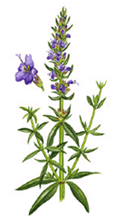
Lavender
Introduction
This fact sheet provides basic information about the herb plant or part of a plant used for its flavor, scent, or potential therapeutic properties. Includes flowers, leaves, bark, fruit, seeds, stems, and roots. lavender-common names, uses, potential side effects, and resources for more information. Lavender is native to the Mediterranean region. It was used in ancient Egypt as part of the process for mummifying bodies. Lavender's use as a bath additive originated in Persia, Greece, and Rome. The herb's name comes from the Latin lavare, which means "to wash."Common Names
lavender, English lavender, garden lavenderLatin Names
Lavandula angustifoliaWhat It Is Used For
- Historically, lavender was used as an antiseptic and for mental health purposes.
- Today, the herb is used for conditions such as anxiety, restlessness, insomnia, and depression.
- Lavender is also used for headache, upset stomach, and hair loss.
How It Is Used
- Lavender is most commonly used in aromatherapyA therapy in which the scent of essential oils from flowers, herbs, and trees is inhaled to promote health and well-being., in which the scent of the essential oil from the flowers is inhaled.
- The essential oil can also be diluted with another oil and applied to the skin.
- Dried lavender flowers can be used to make teas or liquid extracts that can be taken by mouth.
What the Science Says
- There is little scientific evidence of lavender's effectiveness for most health uses.
- Small studies on lavender for anxiety show mixed results.
- Some preliminary results indicate that lavender oil, combined with oils from other herbs, may help with hair loss from a condition called alopecia areata.
Side Effects and Cautions
- Topical use of diluted lavender oil or use of lavender as aromatherapy is generally considered safe for most adults. However, applying lavender oil to the skin can cause irritation.
- Lavender oil may be poisonous if taken by mouth.
- When lavender teas and extracts are taken by mouth, they may cause headache, changes in appetite, and constipation.
- Using lavender with sedative medications may increase drowsiness.
- Tell your health care providers about any complementary and alternative practices you use. Give them a full picture of what you do to manage your health. This will help ensure coordinated and safe care.
Sources
- Lavender. Natural Medicines Comprehensive Database Web site. Accessed on December 28, 2006.
- Lavender (Lavandula angustifolia Miller). Natural Standard Database Web site. Accessed on December 28, 2006.
- Lavender flower. In: Blumenthal M, Goldberg A, Brinckman J, eds. Herbal Medicine: Expanded Commission E Monographs. Newton, MA: Lippincott Williams & Wilkins; 2000:226-229.
- NCCAM National Institutes of Health






